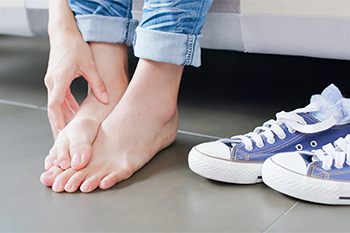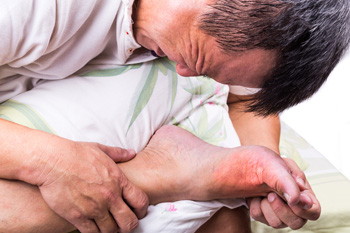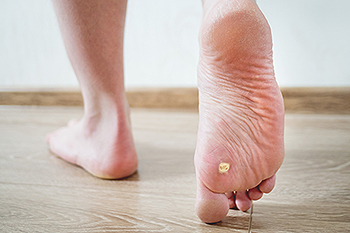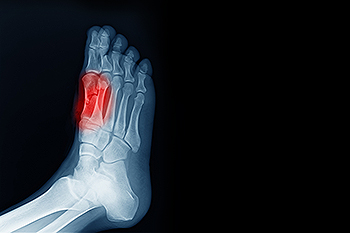Items filtered by date: December 2022
Symptoms of Athlete’s Foot

Athlete's foot can be uncomfortable. It is a foot condition that causes the skin on the feet to itch and become red, and in severe cases, may cause small blisters. It is caused by a fungus called trichophyton and is found in warm and moist environments. These include public swimming pools, locker rooms, and shower room floors. Research has shown it is a common foot ailment, and approximately 70 percent of people worldwide will be infected at some point during their lives. The common symptoms that are associated with athletes’ foot consist of flaking skin and burning between the toes. Athlete’s foot is contagious, and many cases may be prevented by wearing appropriate shoes while in these types of areas. Water shoes and flip flops fall into this category, and wearing these types of shoes may help to reduce the chances of getting athlete's foot. If you or someone you know has this infection, please consult with a podiatrist who can offer you prescribed medication that can cure this ailment.
Athlete’s Foot
Athlete’s foot is often an uncomfortable condition to experience. Thankfully, podiatrists specialize in treating athlete’s foot and offer the best treatment options. If you have any questions about athlete’s foot, consult with Dr. Joshua David Scoll from Pennsylvania. Our doctor will assess your condition and provide you with quality treatment.
What Is Athlete’s Foot?
Tinea pedis, more commonly known as athlete’s foot, is a non-serious and common fungal infection of the foot. Athlete’s foot is contagious and can be contracted by touching someone who has it or infected surfaces. The most common places contaminated by it are public showers, locker rooms, and swimming pools. Once contracted, it grows on feet that are left inside moist, dark, and warm shoes and socks.
Prevention
The most effective ways to prevent athlete’s foot include:
- Thoroughly washing and drying feet
- Avoid going barefoot in locker rooms and public showers
- Using shower shoes in public showers
- Wearing socks that allow the feet to breathe
- Changing socks and shoes frequently if you sweat a lot
Symptoms
Athlete’s foot initially occurs as a rash between the toes. However, if left undiagnosed, it can spread to the sides and bottom of the feet, toenails, and if touched by hand, the hands themselves. Symptoms include:
- Redness
- Burning
- Itching
- Scaly and peeling skin
Diagnosis and Treatment
Diagnosis is quick and easy. Skin samples will be taken and either viewed under a microscope or sent to a lab for testing. Sometimes, a podiatrist can diagnose it based on simply looking at it. Once confirmed, treatment options include oral and topical antifungal medications.
If you have any questions, please feel free to contact one of our offices located in Philadelphia, Bensalem, and Fairless Hills, PA . We offer the newest diagnostic and treatment technologies for all your foot care needs.
Gout Is Caused by Genetic Reasons or From Specific Foods

People who have endured gout attacks cannot ignore the pain that often accompanies this foot condition. Gout is a form of inflammatory arthritis and generally develops in the joints of the big toe. It happens as a result of excess uric acid in the blood, which may come from genetic reasons, or from eating foods with large amounts of purines. These types of foods can include shellfish, red meat, or drinks that are made with large amounts of sugar. This can cause uric acid crystals to form, often beginning in the big toe. People who have endured gout attacks for several years may develop tophi, which are uric acid deposits resembling small lumps under the skin of the affected toe. Gout may eventually resolve naturally. Many people choose to contact a podiatrist who can perform an effective diagnosis and offer treatment methods that are right for you. Additionally, this type of doctor is helpful in explaining how gout attacks can be prevented by implementing simple lifestyle changes.
Gout is a foot condition that requires certain treatment and care. If you are seeking treatment, contact Dr. Joshua David Scoll from Pennsylvania. Our doctor will treat your foot and ankle needs.
What Is Gout?
Gout is a type of arthritis caused by a buildup of uric acid in the bloodstream. It often develops in the foot, especially the big toe area, although it can manifest in other parts of the body as well. Gout can make walking and standing very painful and is especially common in diabetics and the obese.
People typically get gout because of a poor diet. Genetic predisposition is also a factor. The children of parents who have had gout frequently have a chance of developing it themselves.
Gout can easily be identified by redness and inflammation of the big toe and the surrounding areas of the foot. Other symptoms include extreme fatigue, joint pain, and running high fevers. Sometimes corticosteroid drugs can be prescribed to treat gout, but the best way to combat this disease is to get more exercise and eat a better diet.
If you have any questions please feel free to contact one of our offices located in Philadelphia, Bensalem, and Fairless Hills, PA . We offer the newest diagnostic and treatment technologies for all your foot and ankle needs.
Some Children May Be Prone to Plantar Warts

One ailment that can affect children is plantar warts. They are warts that develop on the bottom of the foot due to the pressure the foot endures while walking or running. These types of warts can cause extreme pain and discomfort and may disrupt the ability to run and play. Children may tell their parents that they feel like they are stepping on a small stone and the wart may have the appearance of a cauliflower with black veins in the center. These warts are contagious and the fungus that causes them lives in specific environments. These can include public swimming pools, locker rooms, and shower room floors so it is suggested that children wear appropriate shoes while in these areas. The fungus enters the body through small cracks on the skin and it is beneficial to refrain from sharing towels, shoes, and socks. Children with a weakened immune system may be susceptible to developing a plantar wart. This type of wart can be removed or treated by a podiatrist, so it is suggested that you schedule an appointment if your child is afflicted with this condition.
Plantar warts can be very uncomfortable. If you need your feet checked, contact Dr. Joshua David Scoll from Pennsylvania. Our doctor will assist you with all of your foot and ankle needs.
About Plantar Warts
Plantar warts are the result of HPV, or human papillomavirus, getting into open wounds on the feet. They are mostly found on the heels or balls of the feet.
While plantar warts are generally harmless, those experiencing excessive pain or those suffering from diabetes or a compromised immune system require immediate medical care. Plantar warts are easily diagnosed, usually through scraping off a bit of rough skin or by getting a biopsy.
Symptoms
- Lesions on the bottom of your feet, usually rough and grainy
- Hard or thick callused spots
- Wart seeds, which are small clotted blood vessels that look like little black spots
- Pain, discomfort, or tenderness of your feet when walking or standing
Treatment
- Freezing
- Electric tool removal
- Laser Treatment
- Topical Creams (prescription only)
- Over-the-counter medications
To help prevent developing plantar warts, avoid walking barefoot over abrasive surfaces that can cause cuts or wounds for HPV to get into. Avoiding direct contact with other warts, as well as not picking or rubbing existing warts, can help prevent the further spread of plantar warts. However, if you think you have developed plantar warts, speak to your podiatrist. He or she can diagnose the warts on your feet and recommend the appropriate treatment options.
If you have any questions please feel free to contact one of our offices located in Philadelphia, Bensalem, and Fairless Hills, PA . We offer the newest diagnostic and treatment technologies for all your foot and ankle needs.
Plantar Warts Can Be Treated!
Who Is Prone to Getting Sesamoiditis?

There are bones that are located in the foot which are called the sesamoids. Tendons connect these particular bones to the muscles, and sesamoiditis can happen when these tendons become inflamed. Pain, swelling, and tenderness often accompany this foot condition, and completing daily activities may be difficult to accomplish. The two sesamoid bones are located at the bottom of the foot and big toe, and may also become strained from overuse. People who participate in running and jumping activities may be prone to developing sesamoiditis, and it can be common among dancers. Effective treatment can begin with stopping the activity that caused the injury, and resting the foot as often as possible. Some patients find relief when custom-made orthotics are worn, which may help to provide adequate cushioning. If you have this type of foot pain, please consult with a podiatrist who can properly diagnose and treat sesamoiditis.
Sesamoiditis is an unpleasant foot condition characterized by pain in the balls of the feet. If you think you’re struggling with sesamoiditis, contact Dr. Joshua David Scoll of Pennsylvania. Our doctor will treat your condition thoroughly and effectively.
Sesamoiditis
Sesamoiditis is a condition of the foot that affects the ball of the foot. It is more common in younger people than it is in older people. It can also occur with people who have begun a new exercise program, since their bodies are adjusting to the new physical regimen. Pain may also be caused by the inflammation of tendons surrounding the bones. It is important to seek treatment in its early stages because if you ignore the pain, this condition can lead to more serious problems such as severe irritation and bone fractures.
Causes of Sesamoiditis
- Sudden increase in activity
- Increase in physically strenuous movement without a proper warm up or build up
- Foot structure: those who have smaller, bonier feet or those with a high arch may be more susceptible
Treatment for sesamoiditis is non-invasive and simple. Doctors may recommend a strict rest period where the patient forgoes most physical activity. This will help give the patient time to heal their feet through limited activity. For serious cases, it is best to speak with your doctor to determine a treatment option that will help your specific needs.
If you have any questions please feel free to contact one of our offices located in Philadelphia, Bensalem, and Fairless Hills, PA . We offer the newest diagnostic and treatment technologies for all your foot and ankle needs.

